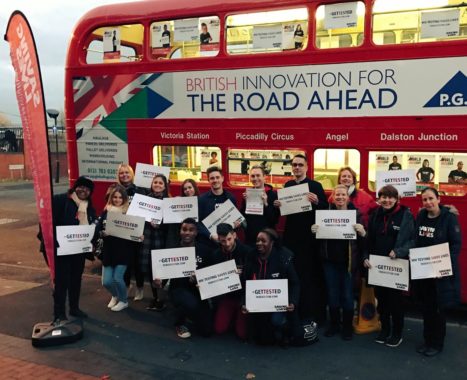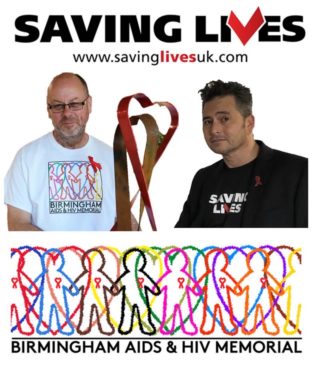The story of Saving Lives’ involvement with the Birmingham AIDS & HIV Memorial begins before either project even existed – because we’ve both long been embedded in the communities of the second city, working towards the same ends for almost two decades.
The six-metre-tall five-tonne steel structure known as “The Ribbons” will be unveiled on World AIDS Day, 2022, and will offer a real focal point for remembering those lost to the virus, educating people about today’s reality of effective medication and normal life expectancies … and for moving forwards together, to achieve all that there is still to do.
Read more about BAHM | Donate to the cause
Garry Jones & The Genesis of BAHM
The original design of and concept for the memorial belongs to Garry Jones, a Birmingham-based artist. Garry was watching the TV drama “It’s A Sin” in January 2021, which took him back to when he was twenty-one in the early 1980s – when the AIDS pandemic really began to hit the shores of the UK.
It got him thinking that there was nothing in his home city of Birmingham by which we can remember those we have loved and lost to HIV/AIDS – and how unfair this was, not just to those we should remember, but also to the work of the legion of community activists Birmingham is home to.
Garry has worked for twenty years in Birmingham on the city’s Pride event. Since 2001, he has brought his artistic skills to bear on ensuring every Pride looks beautiful – working on costumes, set designs, floats and more. That’s how he first met Saving Lives’ Medical Director, Dr Steve Taylor.
“Garry was an inspiration!” Steve remembers. “He was bringing creativity and colour to HIV/AIDS awareness-raising which I immediately saw offered such positivity and hope to all our campaigns.”
Dr Steve Taylor: Working To Improve & Increase HIV Testing
At the same time, Steve was working within the NHS to improve the take-up of HIV testing – in an attempt to increase the diagnosis rates of people living with HIV. As every Birmingham Pride became bigger, and each World AIDS Day went by with the numbers of those infected by the virus but unaware of their status staying stubbornly high, Steve was also campaigning harder and harder.
“Within my own hospital, we were focusing on how to encouraging doctors to think about and recommend HIV testing where they might otherwise not have thought to do so,” says Steve. “But we noticed something: even when offered the test, patients remained reluctant to take one.”
The reason? Stigma played a big part (and unfortunately still does): patients were very wary of the test due to their fear about the assumptions others would make about them and their lifestyle. For example, they erroneously thought that they wouldn’t be able to get a mortgage. To increase testing, Steve and others realised that we had to address this HIV-associated stigma in the wider community.
 World AIDS Day and Saving Lives
World AIDS Day and Saving Lives
Garry was again thinking long similar lines: his Positively Red campaign based at South Birmingham College – and later his alma mater, Birmingham City University – was using drama, fashion, music and dance to tackle prejudice head-on.
“This must have been around 2009 or 2010,” Garry remembers. “We were putting on big shows to showcase World AIDS Day every year – cat walks, theatre events. They were visually impactful and extremely … well, positive! The idea was not to hide HIV/AIDS anymore, but be really visible about it. People needed to talk more about it.”
Around the same time, Steve was working with writer and healthcare communications consultant Dan Hartland. “We’d worked together on many Sexual Health Birmingham projects and developed the website together– essentially a clearing-house of information and advocacy about all aspects of BBVs and STIs,” says Steve, “and we both agreed that we needed to talk about HIV in a new way and reach populations who were simply not hearing the current messaging.”
In 2010, Saving Lives’ World AIDS day campaign was entitled “HIV Testing Saves Lives” was released. The response was quite astonishing: after years of rejection from local football clubs and players to support our sexual health campaigns and getting little traction. The new campaign was attractive – after all, who wouldn’t want to help “save lives” especially when you didn’t have to mention the s*x word.
From WAD 2010, it took Steve and Dan twelve months of hard work to set up the new charity Saving Lives. It was born on world AIDS Day 2011. They now had a new vehicle: a standalone charity that would offer the freedom to do health promotion beyond the NHS.”
By this stage, Steve and Garry were working together closely – on Pride, on World AIDS Day, and on Positively Red. The goal was always to centre the stories of positive people – who could act as examples and role models of what living with HIV meant today. Defeating stigma had to be about lifting up the real experiences – and real lives – of people affected by HIV.
Positive People: Defeating Stigma To Improve Lives
Saving Lives launched in 2011 with a prominent “Positive People” strand, placing “Positive Ambassadors” at the heart of its campaigns. The charity deliberately approached HIV advocacy as an activity to be undertaken among the general population, involving everyone in the story: from football clubs and music venues to sports stadia and schools, Saving Lives set about trying to break down prejudice.
 Just as the charity was successfully promoting better understanding of HIV in unusual places – like the websites and newsletters of football clubs, the pages of The Sun or local BBC radio – funding cuts at the local council meant that Positively Red was no longer able to steward World AIDS Day forward.
Just as the charity was successfully promoting better understanding of HIV in unusual places – like the websites and newsletters of football clubs, the pages of The Sun or local BBC radio – funding cuts at the local council meant that Positively Red was no longer able to steward World AIDS Day forward.
“Birmingham has always been a co-operative city,” Dan says, “so Saving Lives stepping up to continue to provide a strong community presence on World AIDS Day was a no brainer, of course we would. It was a pleasure, and we continued to work with Garry and other local organisations to make things happen across Birmingham.”
The Ribbons and The Future
That co-working has extended to the present day and the Birmingham AIDS & HIV Memorial. When Garry formed a steering committee for the project – including local businessmen Andrew King and Phil Oldershaw as co-founders, and then bringing onboard Steve Ball and Rachel Greaves as key members – how to handle the funds they would need to make the project a success was a key question.
“Our immediate thought was to work with Saving Lives,” says Garry. “It was just a natural fit. We asked them to be our official charity partner, managing our funding and finances – and the rest is history.” The project has also benefitted from the support of Birmingham City Council, The Public Art Gateway Group (PAGG), Southside BID, numerous LGBTQ+, and many other businesses and individuals.
The heart-shaped ribbons of the memorial – constructed by renowned sculptor Luke Perry – symbolise love and hope, the past and the future, those lost to the virus and those who survived. They also symbolise the power of mutual support and working together – and BAHM and Saving Lives have proven over years that co-operation is more powerful than acting alone.


